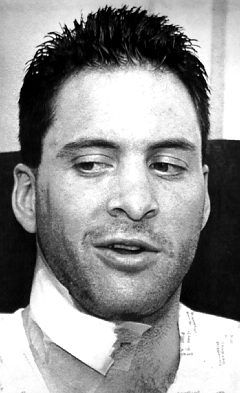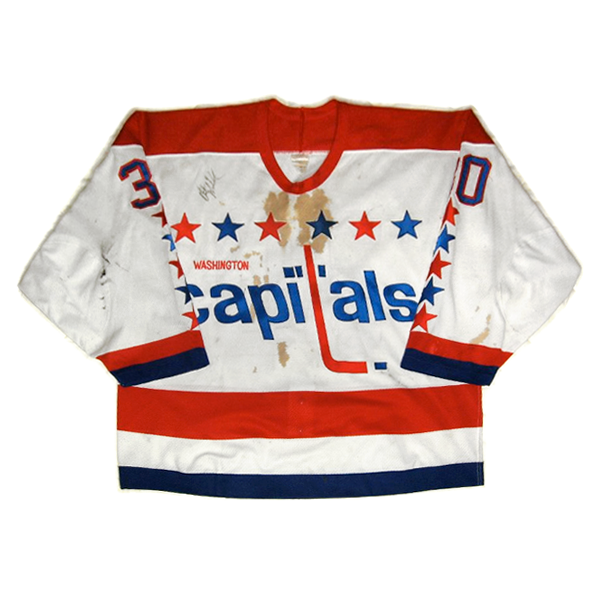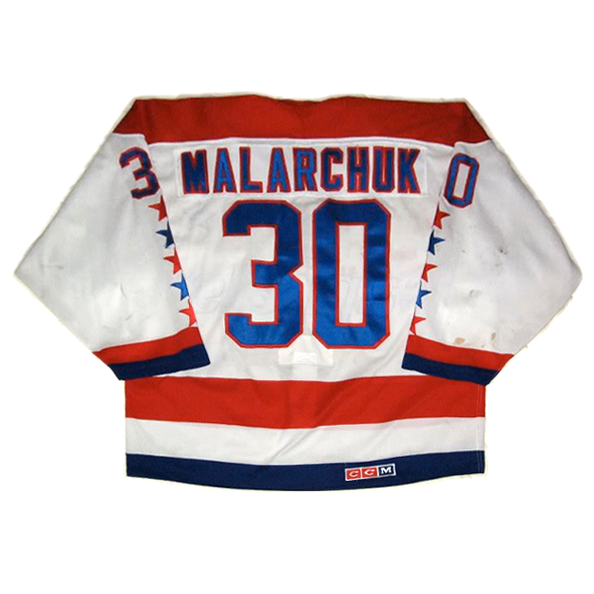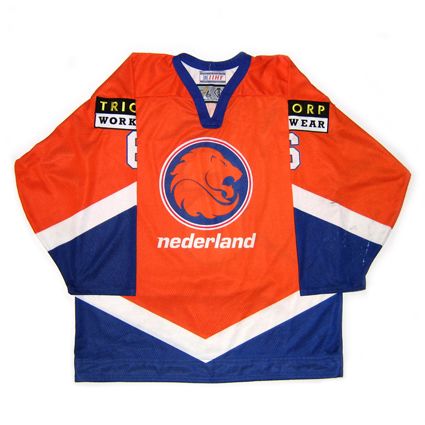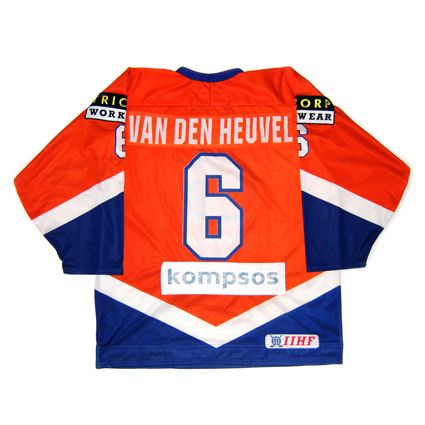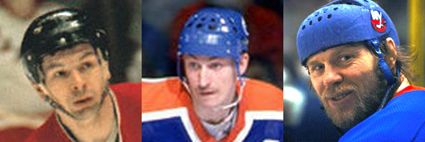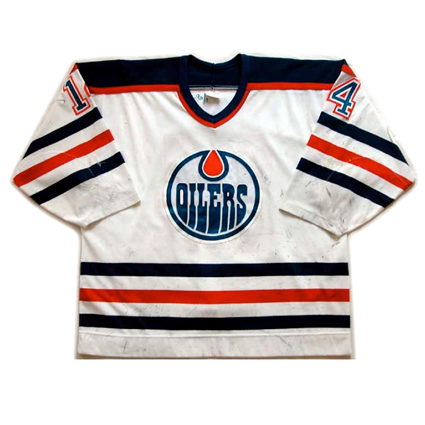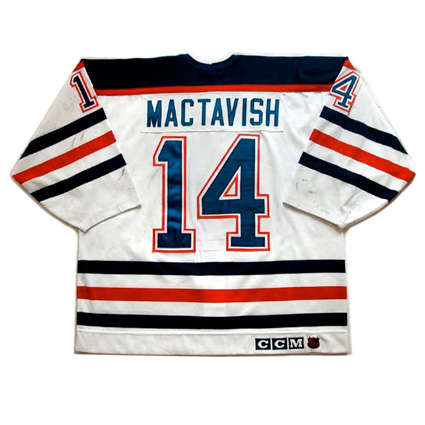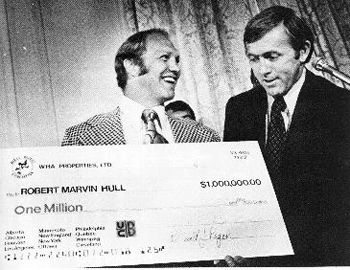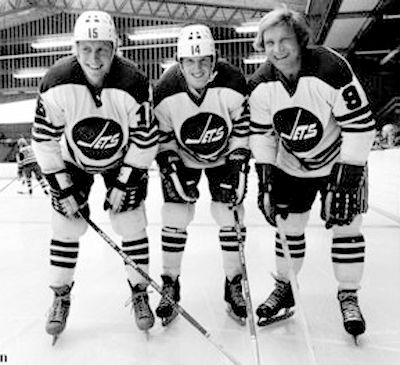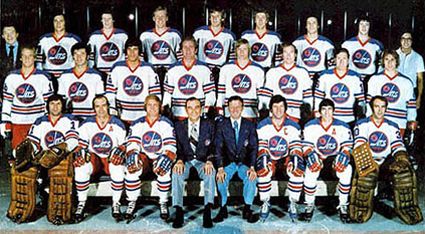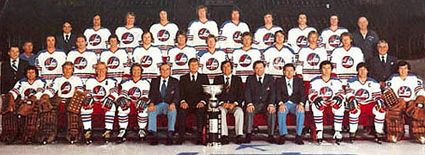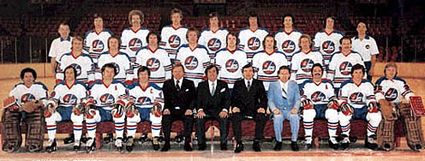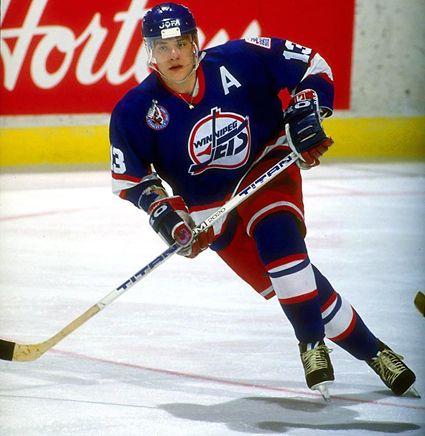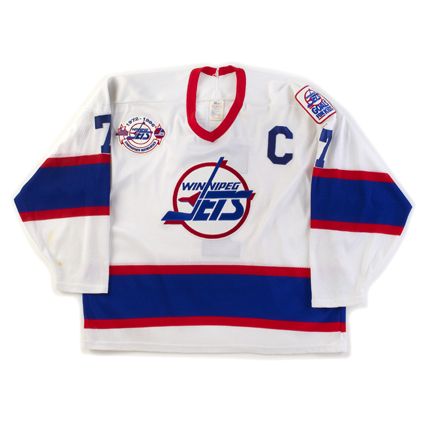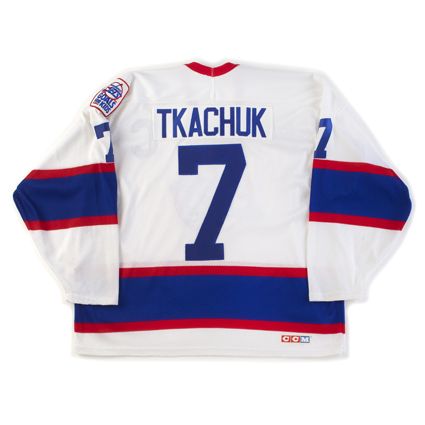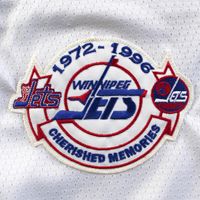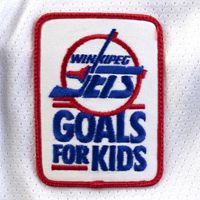Saturday, May 1, 2010
1988-89 Washington Capitals Clint Malarchuk Jersey
Born on this day in 1961, Clint Malarchuk was originally drafted by the Quebec Nordiques #74 overall in the 1981 NHL Entry Draft and spent the majority of the season in the American Hockey League but did make his NHL debut with a pair of appearances with the Nordiques in 1981-82.
He would again spend most of his time in the AHL in 1982-83, but did earn his first NHL victory in 15 games with the Nordiques, posting an 8-5-2 record. The following season he again split time between the AHL and the Nordiques, only this time with the majority of games spent in the NHL, again finishing the season with a winning record of 10-9-2.
Malarchuk played all of 1984-85 with the Fredericton Express in the AHL before becoming a full time NHLer in 1985-86, seeing action in 46 games in Quebec, going 26-12-4. After one more season with the Nordiques, and appearing in a career high 54 games, Malarchuk was traded to the Washington Capitals as part of the deal which brought Dale Hunter to the Capitals.
As the Capitals number one netminder, he matched his career high with 54 games, winning 24 of them and leading the NHL in shutouts with 4. He made it into 42 games with the Capitals in 1988-89 before being traded on March 7th to the Buffalo Sabres who sent Calle Johansson to Washington.
15 days later Malarchuk would suffer a grotesque injury when his throat was slashed by a skate during a game, causing a ghastly scene on the ice as he bled profusely from a severed carotid artery and feared for his life. Sabres trainer Jim Pizzutelli, a former army medic in Vietnam, rushed to his aid to control the bleeding until doctors arrived, saving Malarchuk's life. It took doctors 90 minutes and 300 stitches to close the horrific wound, but Malarchuk would spend just one night in the hospital. Two days later he made an appearance at a Sabres game, receiving a two minute standing ovation. Incredibly, four days after the accident he would return to practice and a week later he played for the last five minutes of the final game of the regular season.
The following season he would play 29 games, going 14-11-2. An increase in games to 37 preceded his last season in the NHL, as he saw action in 29 games as he again split time with Darren Puppa.
Following the conclusion of his NHL career, Malarchuk would play three seasons in the IHL, first with the San Diego Gulls, followed by two with the Las Vegas Thunder, highlighted by going 34-10-7 in 54 games in 1993-94. He would get into 1 game in 1995-96 and three the following season while the assistant general manage and coach to conclude his playing career. His #30 would be the first number retired by the Thunder.
While in Las Vegas, Malarchuk, known for his wacky sense of humor, pulled one of our favorite pranks ever. He told a reporter that he spoke fluent Czech and proceeded to translate the reporter's questions to then 18 year old Radek Bonk, as well as Bonk's replies. The problem was, Malarchuk didn't actually know a single word of Czech, and was speaking gibberish to Bonk, who struggled to keep a straight face throughout!
Today's featured jersey is a 1988-89 Washington Capitals Clint Malarchuk jersey, from his second season in Washington D. C.
This jersey features the five stars down the sleeves, which the Capitals jerseys had from 1974-75 until 1982-83 until going to just four stars for two seasons until reverting back to five again for the 1985-86 season.
The Capitals wore these jerseys from their inception in 1974 all the way through the 1994-95 season. What really sets the authentic version of the Capitals jersey apart from the replica jerseys is that each letter of the Capitals logo on the front is a separate piece of material, rather than the entire crest being embroidered in a smaller size onto a patch, which would then be sewn onto the jersey. Each of the 16 stars on the chest and sleeves are also separate pieces of material which are sewn on. If you can get an old game worn or authentic Capitals jersey, do so, as it is one of the largest differences in quality between the authentic and the replica of any jersey.
Today's video section begins with an interview with Malarchuk shortly after his injury. You have to just shake your head at the part where he says "it's part of the game."
Here is Malarchuk having a full on slugfest with Troy Gamble and then discussing the fight and his subsequent suspension while playing for the Las Vegas Thunder.
Labels:
Malarchuk Clint,
Washington Capitals
Friday, April 30, 2010
Koninginnedag
Today is Koninginnedag, or "Queen's Day" in the Netherlands, which is often referred to as "Holland", when the country celebrates the birthday of the Queen of the Netherlands.
The tradition started on August 31, 1885 on the birthday of Princess Wilhelmina, who later became Queen Wilhelmina. Since 1949, after Queen Juiliana took the throne, Queen's Day is celebrated on her birthday of April 30th. When the current Queen, Queen Beatrix, succeeded her mother Queen Juliana on April 30th, she decided to keep the holiday on April 30th as a tribute to her mother, despite Queen Beatrix's birthday being on January 31st, which comes at a time of year that is far less suited weather-wise for a national holiday which includes many outdoor events.
One of the main outdoor events which Queen's Day is known for it the tradition of "freemarket", where everyone is allowed to sell items on the streets without having to pay taxes on their sales, with the sales in Amsterdam attracting the most visitors. While some sale areas are becoming more commercialized, others are more of a social event and the one in Vondelpark is officially reserved for children.
Other activities are games for children and outdoor concerts as many people dress in the color orange, the color of William I, Prince of Orange, the founder of the Dutch royal family, The House of Orange. Orange is also the color worn by Dutch national sports teams, such as it's successful soccer team despite the colors of it's flag being red, white and blue. Not only do people dress in orange, but there are also orange costumes, drinks and food. The night before Queen's Day is also celebrated in some larger cities, such as Amsterdam, Utrecht and The Hauge, and called Queen's Night, which began as a successful response to rowdyism in the 1990's.
Rather than continue the old tradition of citizens visiting the Queen at Soestdijk Palace, Queen Beatrix instead picks two or three places to visit each year to meet citizens, view local dances and demonstrations of traditional crafts.
The Netherlands National Team first played in 1935 and is currently ranked 25th in the world, competing at the IIHF World Championship Division I level, the second highest level of international hockey. Their highest ranking came in 2004, when they were ranked 23rd.
They competed in the 1980 Olympics in Lake Placid, posting a record of 1-3-1 thanks to a win over Poland and a tie with Japan.
Ron Berteling holds the record for the most games played for the national team with 213 while Jack de Heer has scored the most points with 210. Berteling has been awarded the Frans Henrichs Trophy as the MVP of the Dutch League, while de Heer has a trophy named for him which is given to the leading scorer of the Dutch Super Liga.
The Netherlands currently has 1,800 registered senior players and 1,100 junior players and 21 indoor rinks and they just recently hosted the Division I Group A World Championships in Tilburg where the home squad finished fourth out of six with a win over Lithuania, an overtime win over Serbia and a trio of losses to Japan, Ukraine and Austria remain in Division I for next year.
Today's featured jersey is a 2008 Netherlands National Team Ivy van den Huevel jersey as worn in the 2008 IIHF Division I Group A World Championships in Innsbruck, Austria as well as the IIHF Group C Pre-Olympic Qualification Tournament in Narva, Estonia in November 2008.
The main crest, striping, name, numbers and even the IIHF logo on the back are all dye-sublimated, with the name on a nameplate which was then sewn on, while the sponsorship patch on the back is printed on a patch which was then sewn onto the jersey. The pair of sponsorship patches on the arms are embroidered patches which were then sewn on.
This very attractive jersey in the traditional Dutch color of orange features a striking main logo and some basic, yet effective striping and contrasting blue accent colors for an overall excellent look.
First up in the video section today, a taste of Queen's Day in the Netherlands.
Here is classic footage of the Netherlands versus Canada in the 1980 Olympics. The Netherlands are not wearing their expected orange color, but white jerseys with blue trim.
More classic footage, including a brief interviews with record holding national team players Ron Berteling and Jack de Heer from 1983, as the Netherlands takes on Hungary.
From the recent Division 1 Group A World Championships in Tilburg, the Dutch take on Japan.
Labels:
Netherlands
Thursday, April 29, 2010
1989-90 Edmonton Oilers Craig MacTavish Jersey
An era came to an end on this date in 1997, when Craig MacTavish announced his retirement from the NHL, as MacTavish was the last NHL player to play without a helmet.
When the NHL mandated the use of helmets for all players in 1979, any player already in the league was given the option of continuing to play without protective headgear.
MacTavish was drafted by the Boston Bruins in the 1978 NHL Entry Draft and saw limited NHL action for three seasons as he spent the majority of his time in the American Hockey League, ut it was his 46 games with the Bruins in 1979-80 that allowed him the exemption from the new helmet rules.
He finally made it with the Bruins full time in 1982-83 and got his first extended playoff experience as the Bruins made it to the conference finals that season. After one more year in Boston, MacTavish missed the 1984-85 season following a conviction of vehicular homicide while driving under the influence and spending a year incarcerated. After his release, the Bruins and MacTavish parted ways and MacTavish joined the Edmonton Oilers, where he accepted the role of a checking center on a team loaded with offensive talent.
He would play nine seasons in Edmonton, winning three Stanley Cups in 1987, 1988 & 1990. His best offensive season was in 1988-89 when he scored 21 goals and 31 assists for 52 points, which is the best one can expect playing behind offensive minded centers like Wayne Gretzky and Mark Messier.
Following the departure of Kevin Lowe, MacTavish became the Oilers team captain in 1992 until his late season trade to the New York Rangers in 1994, just in time to help the Rangers capture their famous Stanley Cup championship, their first since 1940.
The following season he signed with the Philadelphia Flyers, where he would play for two seasons before being traded to the St. Louis Blues in 1995-96. He would return to the Blues for the final season of his career in 1996-97 as the last helmetless player in the league.
His final NHL totals show 17 seasons, 1093 games played, 213 goals and 267 assists for 480 points and his name on the Stanley Cup four times. Following his playing career, MacTavish eventually became head coach of the Oilers for eight seasons, including a run to the Stanley Cup Finals in 2006.
The first player to be credited with wearing a helmet on a regular basis for protection in the NHL was George Owen back in 1928, who wore the same helmet while playing for the Bruins that he wore while playing college football. Owen played five seasons for the Bruins, winning a Stanely Cup in 1929.
After suffering a head injury in 1933, Eddie Shore began wearing a helmet for the rest of his career, but it wasn't until the on ice death of the Minnesota North Stars Bill Masterton that players began to embrace the widespread use of the helmet. At the time of the helmet rule being made mandatory 11 years later, 70% of players were wearing helmets.
While many players wear similar helmets, occasionally facial injuries can result in additions to the normal helmet, such as Pat Lafontaine's addition to protect a broken jaw.
Other players notable for their unique helmets were Stan Mikita and his rounded Northland "dome" helment, Wayne Gretzky's Jofa VM lid and Butch Goring, who wore the same Snaps helmet since he was 12 years old, famous for it's small size and lack of gloss while with the New York Islanders.
Goring actually had a pair of the helmets, one for at home and one for the road. They went through several color alterations as Goring moved from the Los Angeles Kings to the Islanders and later the Boston Bruins and eventually the Nova Scotia Oilers to close out his career.
When Goring was traded from the Kings to the Islanders late in the 1979-80 season, the Islanders equipment man didn't have the right paint available and had to improvise while on the road to get Goring in line with the rest of the team, as his road helmet was currently painted Kings' purple while the other was painted gold. The solution was to cover one of the helmets with blue tape, giving the headgear it's distinctive non-glossy, flat appearance, as if it had been flocked.
"It looked pretty good, you couldn't tell the difference." Goring said. "The tape was light enough so it was no big deal, it did the job."
"I didn't wear it for the protection. It was almost why do you wear gloves, why do you wear pads? For me, it was like I didn't know any other way to play hockey other than with my helmet. I grew up in an era where helmets were mandatory as a kid and it just didn't make any sense to take it off because it wasn't anything cumbersome that I needed to get rid of."
"Hockey players are like any other athletes, they get attached to certain things and they had good success and the helmet for me and I actually had a couple of items I kept for a long period of time but I think it is just a comfort zone more than anything else," Goring recalled.
"I didn't wear it for the protection. It was almost why do you wear gloves, why do you wear pads? For me, it was like I didn't know any other way to play hockey other than with my helmet. I grew up in an era where helmets were mandatory as a kid and it just didn't make any sense to take it off because it wasn't anything cumbersome that I needed to get rid of."
"Hockey players are like any other athletes, they get attached to certain things and they had good success and the helmet for me and I actually had a couple of items I kept for a long period of time but I think it is just a comfort zone more than anything else," Goring recalled.
Today's featured jersey is a 1989-90 Edmonton Oilers Craig MacTavish jersey. This jersey was worn during the final championship season of the Oilers era of success.
When the Oilers first joined the NHL they wore Maska jerseys and then Sandow SK brand for two seasons before the change to Nike. It was not until the 1989-90 season that the Oilers began wearing CCM, meaning Gretzky never wore CCM jerseys while with the Oilers in the NHL.
Today's video section begins with a brief look at the history of the hockey helmet and a profile of MacTavish.
Helmets used to come in a wider variety of shapes and sizes. In one of YouTube's finest moments, we present the Toronto Maple Leafs Top 11 Worst Head Gear.
Labels:
Edmonton Oilers,
MacTavish Craig
Wednesday, April 28, 2010
1995-96 Winnipeg Jets Keith Tkachuk Jersey
The late, great original Winnipeg Jets were formed in 1972 as one of the founding teams of the World Hockey Association, which brought professional hockey to several Canadian cities, including Winnipeg, Ottawa, Quebec City, Edmonton and later Toronto, Vancouver and Calgary.
The Jets would make the biggest splash in the league by luring away Bobby Hull from the NHL's Chicago Black Hawks for the unheard of sum of $1,000,000, putting the fledgling league on the map.
Their first season of 1972-73 saw them finish first in the Western Division and make it all the way to the Avco Cup Finals where they would fall to the New England Whalers. While they would fail to qualify for the playoffs the next two seasons, they would set themselves up to be one of the most exciting teams in all of hockey for the next four years by signing Swedes Anders Hedberg and Ulf Nilsson.
The duo, paired with Hull, would electrify the franchise as they finished second, fourth and seventh in league scoring in just their first season together as Hull set a new professional record with 77 goals, although the club failed to qualify for the playoffs.
1975-76 was the season it all came together for the Jets. They tied the Houston Aeros for the most points in the league with 106 as Hull, Nilsson and Hedberg finished second, third and seventh in league scoring. Once in the playoffs they cruised through the Edmonton Oilers 4-0, the Calgary Cowboys 4-1 and swept the Aeros in the finals in four straight to capture their first WHA championship.
While Hull only played in 34 games in 1976-77, Hedberg led the league in goals with 70 as he and Nilsson came two-three in the scoring race. The Jets returned to the Avco Cup Finals but fell to the Quebec Nordiques in seven games.
Hull returned to full-time duty in 1977-78 and the dynamic trio finished with Nilsson, Hedberg and Hull 2-3-4 in scoring, with teammate Kent Nilsson eighth. The Jets finished atop the league standings and defeated the Birmingham Bulls and New England Whalers to take home the championship for the second time.
1978-79 was one of change for the Jets, as Hull would only compete in four games and Hedberg and Nilsson would defect for the bright lights of Broadway when they signed to play for the New York Rangers of the NHL.
Still, the remainder of the Jets would pull through, coming in third in the regular season standings in the final WHA season, but defeat both the Nordiques and then the Oilers to win their second consecutive Avco Cup and their third overall as they went to the league finals for the fifth time in seven seasons.
The Jets, along with New England (Hartford), Edmonton and Quebec were admitted into the NHL for the 1979-80 season, but at a steep price. The restrictive rules placed on the renegade clubs joining the NHL saw the Jets required to relinquish leading scorer Kent Nilsson, Terry Ruskowski (4th in scoring) and Rich Preston (6th). In addition, leading scorer among defensmen Barry Long was also gone from the roster. Forced to draft 18th out of 21, the Jets would finish dead last in the NHL for the next two seasons.
Acquiring Dale Hawerchuk in the 1981 draft started the Jets back on the road to respectability. Eventually the Jets would claim fourth overall in the league in 1984-85, but were doomed by finding themselves in the same division with league powerhouses Edmonton and the Calgary Flames. With the current divisional playoff format of the time, the Jets were forced to face the Oilers at the height of their dynasty no less than six times in the eight seasons between 1983 and 1990, losing each and every series while winning a total of only four games as the Oilers went on to win five Stanley Cups and the Flames one during that time period.
While the Jets playoff success in the NHL was derailed by the Oilers dynasty, one enduring memory is the "White Out", which arrived in the 1987 playoffs when the Jets asked fans to wear white to home playoff games in response to the Flames "C of Red". Following their four game sweep of Calgary that season, a tradition was born which the franchise continues to employ to this day.
While they were a competitive club on the ice, it became increasingly difficult for the Jets to compete financially, being the fourth smallest market in the NHL (pop. 675,000 and about the size as Omaha, Nebraska), and hampered by playing in the Winnipeg Arena which opened in 1955 and lacked the modern amenities such as luxury boxes and club seating required to keep pace in the modern sports landscape.
They tried to remain competitive, including trading Hawerchuk to Buffalo in 1990 for Phil Housley, Scott Arniel, Jeff Parker and a draft pick which would become Keith Tkachuk.
1992-93 saw the arrival of Russian Alexi Zhamnov, the bruising Tie Domi and the dynamic Finn Teemu Selanne, who would electrify the city with 76 goals as a rookie.
Still, playoff success eluded the Jets and they slipped in the standings, completely missing out on the playoffs in 1994 and 1995.
With the weaker Canadian dollar of the day hurting the franchise financially, eventually the push for a new arena began, which was eventually unsuccessful, making the owners of the club willing to sell the team they viewed as inviable. When it proved impossible to find a local buyer, the owners announced their intention in May of 1995 to sell the club to buyers from outside of Winnipeg, who would inevitably move the team.
The fans of Winnipeg rallied in a way never seen before or since. The "Save the Jets" rally at The Forks on May 16, 1995 drew over 35,000 people in an effort to raise funds to purchase the franchise. While an astonishing outpouring generated a reported $13 million, it fell far short of the over $110 million required and it was announced on October 18, 1995 that the team had been sold to Americans Richard Burke and Steven Gluckstern, who had originally hoped to move the club to the Twin Cities of Minneapolis and St. Paul, Minnesota, and with the Jets eventually landing in the most unlikely of places, in the desert of Phoenix, Arizona.
Still, the Jets would play one final season in Winnipeg before any relocation was to happen. Morale among the fans only deteriorated further when Selanne, who won over the hearts of Winnipeggers with his scoring exploits and personality is sent to the Mighty Ducks of Anaheim in February of 1996 in a salary dump. For a city about to lose it's franchise, having it's most beloved player since Bobby Hull miss the going away party was a real kick in the stomach.
A rise in the standings in 1995-96 saw the lame duck Jets qualify for the playoffs on the final day of the season to put the moving vans on hold for as long as the team could last in the postseason. Paired against the Red Wings in the playoffs, Detroit took the first to games at home while the Jets responded by winning Game 3 at home. Detroit then won at Winnipeg to put the Jets on the brink, but they staved off elimination with a 3-1 win in Detroit to return home to Winnipeg, but the end came for the Jets with a 4-1 loss in their final game on this date in 1996.
Today's featured jersey is a 1995-96 Winnipeg Jets Keith Tkachuk jersey as worn in the final game in Jets history, a loss at home which eliminated the Jets from the playoffs for a final time. This jersey features the Cherished Memories worn during the final ten games in Jets history plus their playoff series versus Detroit. There was also a blue version worn on the road jerseys.
Tkachuk wore the captain's "C" for that game, as regular team captain that season Kris King was out of action with an injury.
Apologies in advance for more video today than you can shake a hockey stick at, but we felt it was all relevant and worth including.
Most importantly, one of our favorite hockey videos ever. At an hour long, it's a lot to ask of our readers accustomed to our usual brief videos, but ladies and gentlemen, we present to you the genius that is "Death by Popcorn - The Tragedy of the Winnipeg Jets".
Not recommended for those of you at work due to it's length and a couple of unfortunate rough spots in the language from the Oilers jersey wearing "man on the street" 10 and 34 minutes into the video, but it's essential viewing if only for Hawerchuk's speech on the occasion of his induction into the Hockey Hall of Fame.
Next, the announcement in May, 1995 following the end of the 1994-95 season that the efforts to save the Jets have failed and the franchise will be relocated.
Now, "The Funeral", a 90 minute farewell gathering at the Winnipeg Arena to say goodbye at the conclusion of the 1994-95 season to the team and retire Thomas Steen's #25 on May 6, 1995 (in ten parts), which inspired the "Save the Jets" fundraising campaign and gathering of 35,000 fans ten days later in Winnipeg.
Here is a news report, first on the plight of the Quebec Nordiques, and then a look at public efforts to save the Jets by raising enough money to purchase the team to prevent the current ownership from moving the team, which would ultimately fail. The Nordiques would in fact move to Denver for the start of the 1995-96 season, but the Jets will remain in Winnipeg for one final lame duck season.
Now, an interview with Selanne from the "Save the Jets" rally ten days after "The Funeral", followed by the player introductions at the rally followed by John Paddock and then Randy Gilhen addressing the gathering.
Next, Tkachuk scores his 50th goal of the season in the final regular season game in Jets history on April 12, 1996 to earn the Jets a playoff berth, followed by a report on "Puck-gate", as none other than Wayne Gretzky makes off with the puck from the final game!
In this video, the Jets get help from a higher power in the effort to stay in Winnipeg.
Highly recommended viewing, the half hour documentary on the Winnipeg Jets and their financial issues from TSN - "Winnipeg Jets - For the Love of the Game", which includes an interview with NHL commissioner Gary Bettman.
If we haven't put enough demands on your time today, here is our final effort to cost you your job if you are viewing all this at work, here is the conclusion of the final game in Winnipeg Jets history, their 4-1 loss at home to close out their playoff series against Detroit on this day in 1996.
Labels:
Tkachuk,
Winnipeg Jets
Subscribe to:
Comments (Atom)


